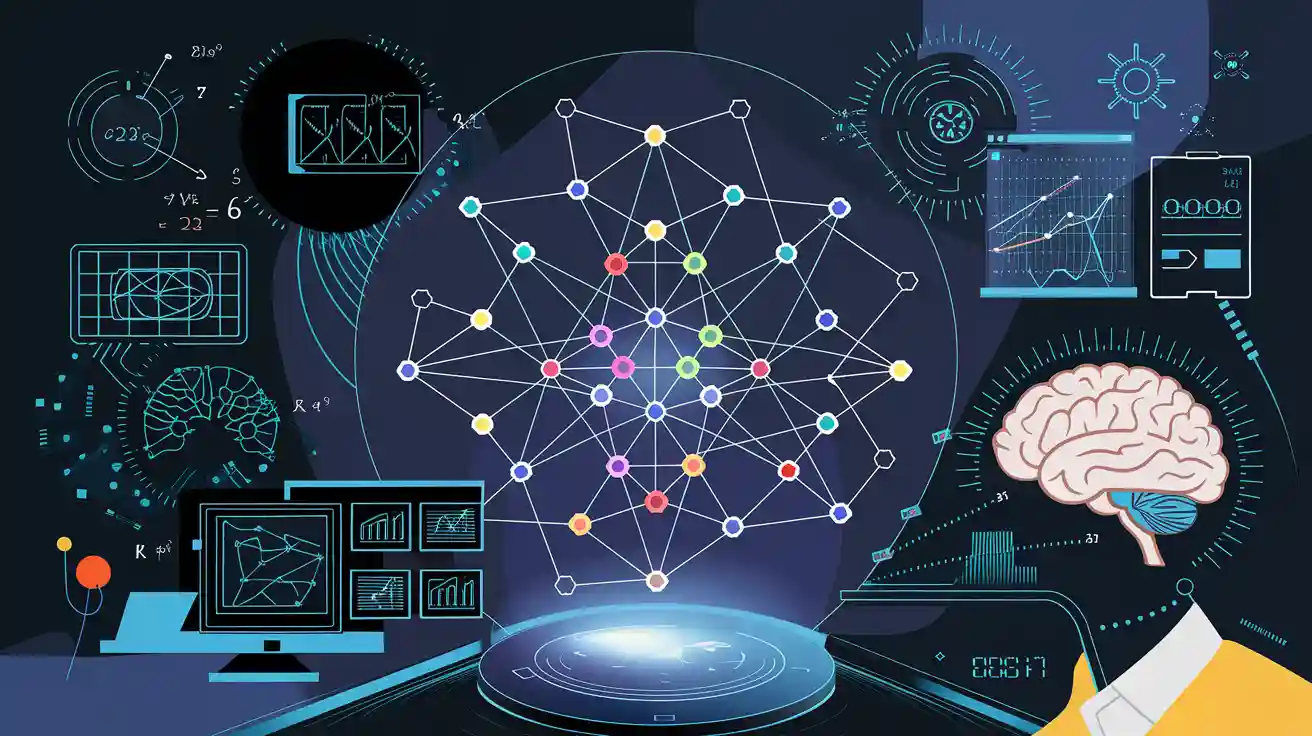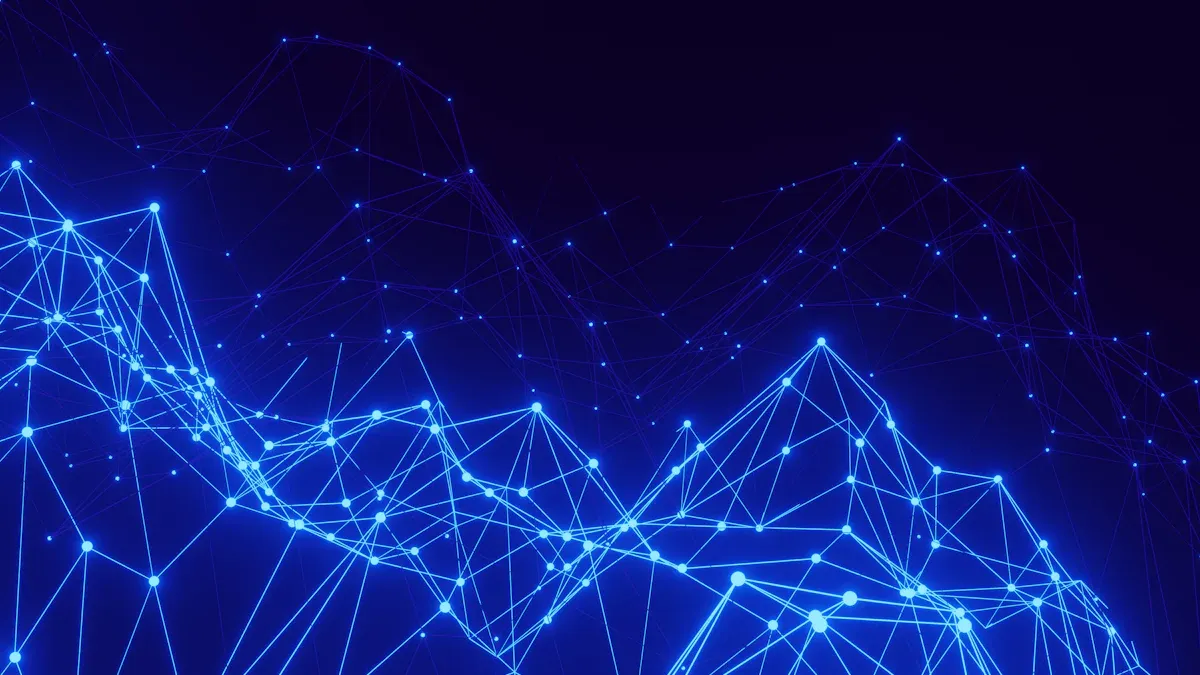
You encounter challenges in AI that demand advanced solutions. Neural networks excel in these scenarios, outperforming traditional algorithms in generative tasks. Studies reveal their efficiency and accuracy in handling complex data. For instance, Amazona and Hernandez (2019) achieved 98% precision and recall, showcasing how neural networks redefine problem-solving in modern machine learning.
Key Takeaways
-
Neural networks work like the human brain. They help machines find patterns and solve hard problems well.
-
Training neural networks uses forward propagation to handle data. Backpropagation helps them fix mistakes and get better over time.
-
Neural networks are great for tasks like recognizing pictures, understanding language, and making predictions. They are very important in today’s AI.
Understanding Neural Networks in Machine Learning
What Are Neural Networks
Neural networks are computational models inspired by the human brain. They consist of interconnected nodes, or “neurons,” that process information in layers. These networks excel at recognizing patterns, making predictions, and solving problems. Unlike traditional algorithms, neural networks adapt and improve over time by learning from data.
You can think of neural networks as systems that mimic how humans learn. For example, when you see a cat, your brain identifies it by recognizing patterns like its shape, fur, and movement. Similarly, neural networks analyze data to identify patterns and make decisions. This ability makes them essential in fields like image recognition, natural language processing, and predictive analytics.
The Structure and Function of Neural Networks
The structure of a neural network determines how it processes information. Each network consists of three main components:
-
Input Layer: This layer receives raw data, such as images or text.
-
Hidden Layers: These layers perform complex computations to extract patterns and features.
-
Output Layer: This layer provides the final result, such as a prediction or classification.
The function of a neural network depends on its architecture. For instance, feedforward networks process data in one direction, while recurrent networks handle sequential data by retaining information from previous steps. Researchers use various metrics to analyze the structure and performance of neural networks. The table below highlights some key metrics:
|
Metric/Statistic |
Description |
|---|---|
|
Graph Metrics |
Explains the link between network performance and structure. |
|
Recurrent Depth |
Measures the depth of recurrent connections in a network. |
|
Feedforward Depth |
Measures the depth of feedforward connections in a network. |
|
Recurrent Skip Coefficient |
Indicates the ability of a network to handle long-term dependencies. |
|
Hierarchical Structures |
Analyzes the organization of neurons in layers. |
|
Performance Correlation |
Investigates how structural metrics correlate with network performance. |
Understanding these metrics helps you evaluate how well a neural network can solve specific problems.
Why Neural Networks Are Crucial in AI and Machine Learning
Neural networks play a pivotal role in modern AI and machine learning. They enable machines to perform tasks that were once exclusive to humans. Here are some reasons why they are indispensable:
-
Neural networks mimic the human brain, allowing machines to recognize patterns and solve problems.
-
They power applications like image recognition, speech processing, and autonomous systems.
-
By learning from data, neural networks improve their accuracy over time, making them highly effective tools.
For example, in image recognition, neural networks can identify objects with remarkable precision. In natural language processing, they enable AI chatbots to understand and respond to human queries. Their adaptability and learning capabilities make them essential for tackling complex challenges in AI.
Types of Neural Networks and Their Applications

Single-Layer Perceptrons: The Foundation of Neural Networks
Single-layer perceptrons represent the simplest form of neural networks. They consist of a single layer of neurons that process input data and produce an output. While these models laid the groundwork for neural network development, their limitations became evident over time.
-
Single-layer perceptrons struggled to learn complex patterns, such as the XOR problem.
-
The book Perceptrons by Minsky and Papert (1969) highlighted these shortcomings, leading to a temporary decline in neural network research.
-
The discovery that multilayer perceptrons could solve problems beyond the capabilities of single-layer perceptrons marked a pivotal moment in the evolution of neural networks.
Despite their simplicity, single-layer perceptrons remain a critical milestone in the history of machine learning.
Multi-Layer Perceptrons (MLPs) for General AI Tasks
Multi-layer perceptrons (MLPs) expanded the capabilities of neural networks by introducing hidden layers. These layers enable MLPs to learn complex patterns and solve diverse problems.
-
MLPs achieved a test accuracy of 99% on the MNIST dataset, showcasing their effectiveness in classifying handwritten digits.
-
Techniques like dropout, data augmentation, and learning rate scheduling enhanced their performance.
-
A confusion matrix revealed high precision and recall across all digit classes, demonstrating their robustness.
You can rely on MLPs for general AI tasks, such as image classification and predictive modeling, due to their adaptability and precision.
Convolutional Neural Networks (CNNs) for Image and Video Analysis
Convolutional neural networks (CNNs) specialize in processing visual data. Their architecture includes convolutional layers that extract features from images and videos.
-
CNNs outperformed traditional machine learning methods on 7 out of 10 datasets, including DS01, DS02, and DS04.
-
While models like XGBoost and Random Forest performed competitively, CNNs showed greater consistency across datasets.
-
CNNs excel in applications like facial recognition, object detection, and video analysis.
If you need a neural network for visual tasks, CNNs are the go-to choice.
Recurrent Neural Networks (RNNs) for Sequential Data Processing
Recurrent neural networks (RNNs) handle sequential data, such as time series or text. Their ability to retain information from previous steps makes them ideal for tasks involving temporal dependencies.
-
RNNs performed well on datasets like DS07 and DS04, proving their effectiveness in certain scenarios.
-
However, they struggled on datasets like DS08, where performance dropped to 3.78%.
You can use RNNs for applications like speech recognition, language modeling, and stock price prediction.
Advanced Architectures: GANs, Transformers, and Specialized Models
Advanced neural network architectures have revolutionized AI. Generative adversarial networks (GANs) and transformers represent significant breakthroughs.
-
GANs generate realistic content, such as images and videos, while transformers like BERT and GPT excel in language processing.
-
Innovations like StyleGAN allow for precise control over image attributes, enabling the creation of photorealistic visuals.
-
Generative AI powered by these models has transformed industries, including drug development, product design, and supply chain management.
These specialized models push the boundaries of what neural networks can achieve, making them indispensable in modern AI.
How Neural Networks Solve Complex Problems
The Role of Neurons and Network Layers
Neurons and network layers form the backbone of artificial neural networks. Each neuron processes information and passes it to the next layer, creating a chain of computations that solve complex problems. You can think of neurons as tiny decision-makers. They analyze input data, apply weights, and produce outputs that contribute to the network's overall performance.
Network layers play a crucial role in determining how data flows through the system. The input layer receives raw data, hidden layers extract meaningful features, and the output layer delivers the final result. The depth and number of layers influence the network's ability to learn intricate patterns. For example, deep learning algorithms use multiple hidden layers to process large datasets, enabling them to recognize subtle details in images or text.
The document highlights the importance of analyzing individual neurons and network layers to understand their contributions to neural network performance. It points out that while many studies have focused on the collective behavior of neurons, there is a significant need to examine the interactions between individual weights and synaptic connections during training.
By understanding the role of neurons and layers, you can appreciate how neural networks tackle challenges like image recognition, speech processing, and predictive analytics.
Training Neural Networks: Forward Propagation and Backpropagation
Training neural networks involves two key processes: forward propagation and backpropagation. Forward propagation is the initial step where data moves through the network. Each layer processes the input, applies weights, and generates an output. This process continues until the final layer produces a prediction or classification.
Backpropagation, on the other hand, is the learning phase. It adjusts the weights of neurons based on the error between the predicted output and the actual result. You can think of it as a feedback loop. The network calculates the error, propagates it backward, and updates the weights to improve accuracy.
For example, if a neural network misclassifies an image, backpropagation helps it learn from the mistake. By refining the weights, the network becomes better at recognizing patterns over time. This iterative process is essential for training deep learning algorithms, ensuring they perform well on complex tasks.
Learning from Data: Optimization and Performance Improvement
Neural networks rely on optimization techniques to learn from data and enhance their performance. Optimization algorithms, such as stochastic gradient descent (SGD), adjust the weights and biases of neurons to minimize error. These algorithms ensure the network converges toward the best solution for a given problem.
You can improve a neural network's performance by using techniques like regularization, dropout, and data augmentation. Regularization prevents overfitting by penalizing large weights, while dropout randomly disables neurons during training to enhance generalization. Data augmentation increases the diversity of training data, helping the network learn robust patterns.
For instance, in image recognition tasks, augmenting the dataset with rotated or cropped images allows the network to recognize objects from different perspectives. These strategies ensure neural networks remain adaptable and effective, even when faced with challenging datasets.
Real-World Applications of Neural Networks

Image Recognition and Computer Vision
Neural networks have transformed image recognition and computer vision tasks. You can use them to identify objects, detect faces, and analyze visual data with remarkable precision. Models like Convolutional Neural Networks (CNNs) and Vision Transformers (ViT) excel in these areas. ViT models, for instance, surpass traditional CNNs in benchmarks after pre-training on large datasets. While CNNs achieved 75% accuracy in 10 epochs, ViT models approached state-of-the-art performance with longer training times.
These advancements benefit industries like healthcare and security. Mobile apps powered by neural networks can detect skin cancer early, saving lives. In surveillance systems, neural networks enhance facial recognition accuracy, ensuring reliable identification. Their ability to process vast amounts of visual data makes them indispensable in modern machine learning applications.
Natural Language Processing and AI Chatbots
Neural networks drive breakthroughs in natural language processing (NLP). You can see their impact in AI chatbots, virtual assistants, and language translation tools. Models like GPT and BERT use transformers to understand context and generate human-like responses. This technology enables chatbots to answer queries, assist customers, and even write coherent text.
For example, AI-powered chatbots in e-commerce improve customer experiences by providing instant support. Neural networks also help translate languages, bridging communication gaps across cultures. Their adaptability ensures they remain effective in diverse NLP tasks, making them essential for businesses and individuals alike.
Predictive Analytics in Healthcare and Finance
Neural networks excel in predictive analytics, helping you make informed decisions in healthcare and finance. In healthcare, they analyze patient data to predict diseases and recommend treatments. Early detection of conditions like skin cancer through mobile apps showcases their societal benefits.
In finance, companies like MJ Futures and Bridgewater Associates use neural networks for stock market predictions. MJ Futures reported a 199.2% return over two years, highlighting the predictive power of these models. Hedge funds rely on neural networks for fraud detection and portfolio management, ensuring better outcomes. Their ability to learn from data makes them invaluable in these critical sectors.
Autonomous Systems: Vehicles and Robotics
Autonomous systems rely on neural networks for perception and decision-making. You can see their impact in self-driving cars and robotics. These systems use deep learning to process sensor data, navigate environments, and avoid obstacles.
Safety remains a priority in autonomous vehicles. Neural networks monitor performance using uncertainty estimation methods. For example, they represent perception as a probability distribution to account for environmental changes like rain or snow. This approach ensures vehicles operate safely within their design domains. Robotics also benefit from neural networks, enabling precise movements and adaptive behaviors in dynamic settings.
|
Key Aspect |
Description |
|---|---|
|
Uncertainty Representation |
Deep learning-based perception is represented as a probability distribution to account for uncertainty in autonomous driving. |
|
Safety Mechanism |
The approach anticipates hazardous uncertainty and reduces performance when necessary, ensuring safety during deployment. |
|
Applicability |
Demonstrated effectiveness in various deployment scenarios, including transitions into different environmental conditions (e.g., night, rain, snow). |
Neural networks continue to shape the future of autonomous systems, ensuring efficiency and safety in real-world applications.
Neural networks have transformed AI by solving problems with unmatched efficiency. You see their impact in fields like healthcare and robotics. Their evolution drives advancements in natural language processing and diagnostics. Over 60 countries investing in AI strategies highlights their importance. Smaller, efficient models ensure accessibility, shaping the future of AI innovation.
FAQ
What makes neural networks different from traditional algorithms?
Neural networks learn from data by adjusting weights and biases. Traditional algorithms follow predefined rules. This adaptability allows neural networks to solve complex, dynamic problems.
How do neural networks improve over time?
Neural networks improve through training. They adjust weights using optimization techniques like backpropagation. This process reduces errors and enhances their ability to recognize patterns.
Can neural networks handle real-world challenges?
Yes! Neural networks excel in tasks like image recognition, language processing, and autonomous systems. Their ability to learn and adapt makes them ideal for solving real-world problems. 🚀







